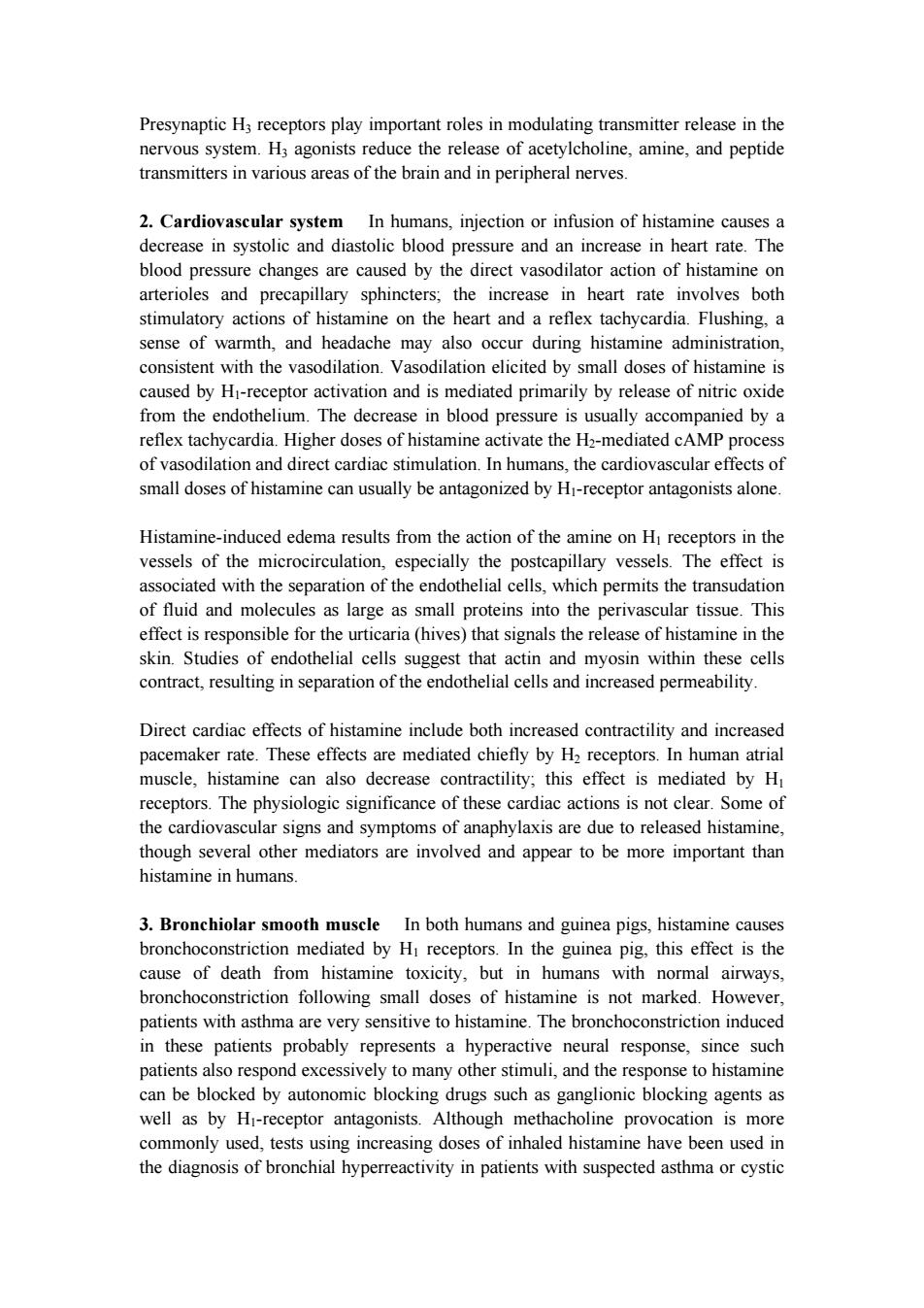正在加载图片...

Presynaptic H3 receptors play important roles in modulating transmitter release in the nervous system.H3 agonists reduce the release of acetylcholine,amine,and peptide transmitters in various areas of the brain and in peripheral nerves. 2.Cardiovascular system In humans,injection or infusion of histamine causes a decrease in systolic and diastolic blood pressure and an increase in heart rate.The blood pressure changes are caused by the direct vasodilator action of histamine on arterioles and precapillary sphincters;the increase in heart rate involves both stimulatory actions of histamine on the heart and a reflex tachycardia.Flushing,a sense of warmth,and headache may also occur during histamine administration, consistent with the vasodilation.Vasodilation elicited by small doses of histamine is caused by Hi-receptor activation and is mediated primarily by release of nitric oxide from the endothelium.The decrease in blood pressure is usually accompanied by a reflex tachycardia.Higher doses of histamine activate the H2-mediated cAMP process of vasodilation and direct cardiac stimulation.In humans,the cardiovascular effects of small doses of histamine can usually be antagonized by Hi-receptor antagonists alone. Histamine-induced edema results from the action of the amine on HI receptors in the vessels of the microcirculation,especially the postcapillary vessels.The effect is associated with the separation of the endothelial cells,which permits the transudation of fluid and molecules as large as small proteins into the perivascular tissue.This effect is responsible for the urticaria(hives)that signals the release of histamine in the skin.Studies of endothelial cells suggest that actin and myosin within these cells contract,resulting in separation of the endothelial cells and increased permeability. Direct cardiac effects of histamine include both increased contractility and increased pacemaker rate.These effects are mediated chiefly by H2 receptors.In human atrial muscle,histamine can also decrease contractility;this effect is mediated by H receptors.The physiologic significance of these cardiac actions is not clear.Some of the cardiovascular signs and symptoms of anaphylaxis are due to released histamine, though several other mediators are involved and appear to be more important than histamine in humans. 3.Bronchiolar smooth muscle In both humans and guinea pigs,histamine causes bronchoconstriction mediated by HI receptors.In the guinea pig,this effect is the cause of death from histamine toxicity,but in humans with normal airways, bronchoconstriction following small doses of histamine is not marked.However, patients with asthma are very sensitive to histamine.The bronchoconstriction induced in these patients probably represents a hyperactive neural response,since such patients also respond excessively to many other stimuli,and the response to histamine can be blocked by autonomic blocking drugs such as ganglionic blocking agents as well as by Hi-receptor antagonists.Although methacholine provocation is more commonly used,tests using increasing doses of inhaled histamine have been used in the diagnosis of bronchial hyperreactivity in patients with suspected asthma or cysticPresynaptic H3 receptors play important roles in modulating transmitter release in the nervous system. H3 agonists reduce the release of acetylcholine, amine, and peptide transmitters in various areas of the brain and in peripheral nerves. 2. Cardiovascular system In humans, injection or infusion of histamine causes a decrease in systolic and diastolic blood pressure and an increase in heart rate. The blood pressure changes are caused by the direct vasodilator action of histamine on arterioles and precapillary sphincters; the increase in heart rate involves both stimulatory actions of histamine on the heart and a reflex tachycardia. Flushing, a sense of warmth, and headache may also occur during histamine administration, consistent with the vasodilation. Vasodilation elicited by small doses of histamine is caused by H1-receptor activation and is mediated primarily by release of nitric oxide from the endothelium. The decrease in blood pressure is usually accompanied by a reflex tachycardia. Higher doses of histamine activate the H2-mediated cAMP process of vasodilation and direct cardiac stimulation. In humans, the cardiovascular effects of small doses of histamine can usually be antagonized by H1-receptor antagonists alone. Histamine-induced edema results from the action of the amine on H1 receptors in the vessels of the microcirculation, especially the postcapillary vessels. The effect is associated with the separation of the endothelial cells, which permits the transudation of fluid and molecules as large as small proteins into the perivascular tissue. This effect is responsible for the urticaria (hives) that signals the release of histamine in the skin. Studies of endothelial cells suggest that actin and myosin within these cells contract, resulting in separation of the endothelial cells and increased permeability. Direct cardiac effects of histamine include both increased contractility and increased pacemaker rate. These effects are mediated chiefly by H2 receptors. In human atrial muscle, histamine can also decrease contractility; this effect is mediated by H1 receptors. The physiologic significance of these cardiac actions is not clear. Some of the cardiovascular signs and symptoms of anaphylaxis are due to released histamine, though several other mediators are involved and appear to be more important than histamine in humans. 3. Bronchiolar smooth muscle In both humans and guinea pigs, histamine causes bronchoconstriction mediated by H1 receptors. In the guinea pig, this effect is the cause of death from histamine toxicity, but in humans with normal airways, bronchoconstriction following small doses of histamine is not marked. However, patients with asthma are very sensitive to histamine. The bronchoconstriction induced in these patients probably represents a hyperactive neural response, since such patients also respond excessively to many other stimuli, and the response to histamine can be blocked by autonomic blocking drugs such as ganglionic blocking agents as well as by H1-receptor antagonists. Although methacholine provocation is more commonly used, tests using increasing doses of inhaled histamine have been used in the diagnosis of bronchial hyperreactivity in patients with suspected asthma or cystic